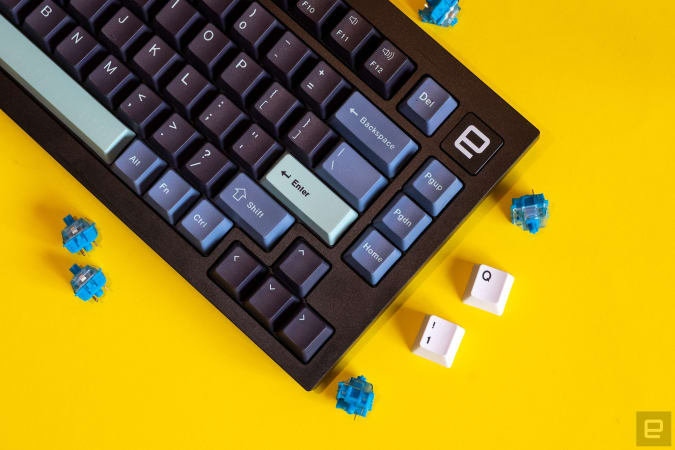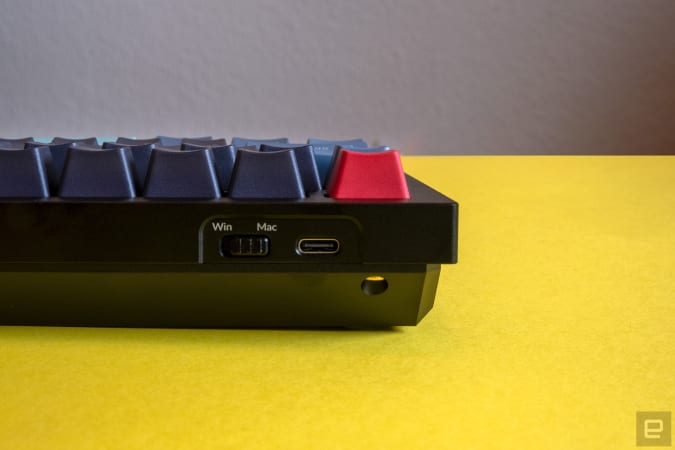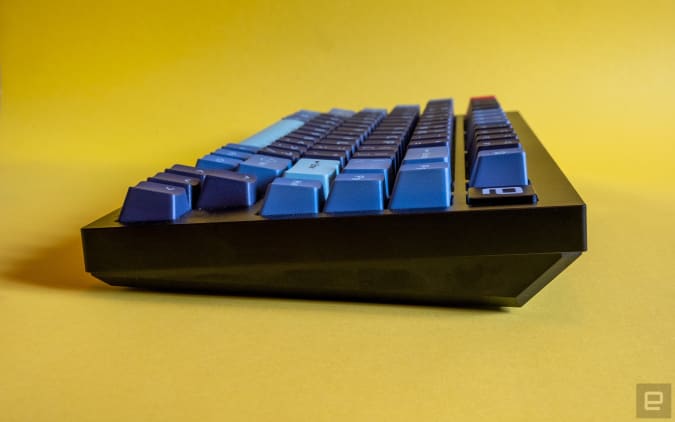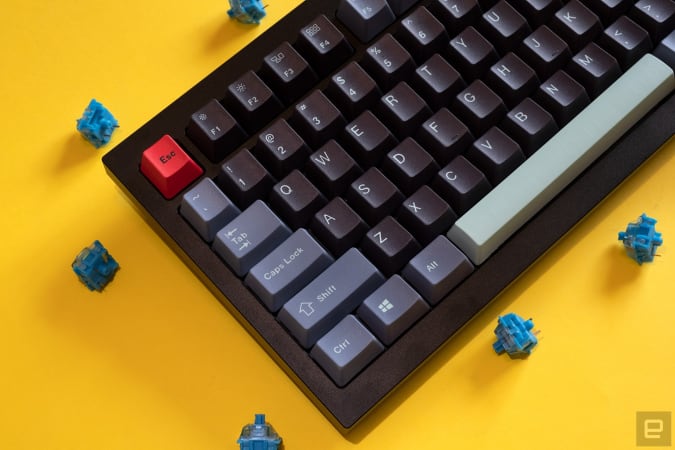
[ad_1]
The humble computer keyboard might feel utilitarian, but given it’s the part of your setup you interact with the most, it’s kinda wild that we don’t often give it thought. Fortunately, there’s a vibrant scene of small (and not so small) companies that understand everyone’s needs are different and that getting the right size, shape and ergonomic layout can upgrade your working or gaming life in significant ways. Keychron is one such company.
Keychron has earned a reputation for making affordable yet feature-rich , and (starting at $169) is the latest member of the family. The Q is a nod to , a popular open-source firmware that lets you customize compatible keyboards to your liking. It’s Keychron’s most ambitious deck yet, and a direct competitor to something like the or the , both of which cost north of $250 depending on your preferred configuration.
The Q1 is a 75-percent keyboard, which means there’s no number pad and the home cluster and arrow keys are placed a little more tightly compared to a tenkeyless deck (that gives those keys a little more space of their own). The Q1 is Mac- and Windows compatible and comes with an cable so that people know you really mean business. Alas, there’s no Bluetooth option here if that’s something you wanted.
As customization is the key here (no pun intended), it’s no surprise that the switches are hot-swappable. Keychron already offers a decent , though you can of course grab your own if you have a preferred set already. If you already own switches you like, you can order the barebone deck and save $20. You can also choose from three aluminum case colors: black, navy and space gray. Both ANSI and ISO layouts are available depending on your preference (or, more likely, location).

James Trew / Engadget
One thing I love about all Keychron keyboards is that they not only come with a keycap puller tool and a switch remover tool (where applicable), but you’ll also get the keycaps for both Windows and MacOS layouts. This makes it easy for the company just to stock one SKU and possibly helps keep costs down. If, like me, you use both operating systems — you can then repurpose any of their keyboards without having to buy new caps later. Or worse, live with a CMD key when you want a Windows key or vice versa.
A fancy keyboard isn’t anything without RGB lighting, of course, and naturally, that’s included here too. Keychron opted for a more subtle “south-facing” integration, which pretty much means what you think: The lights are only visible from below. I don’t need or use RGB, so I tend to turn it off. The implementation here is subtle yet bright enough to still remain useful if it’s something you want.
For the more hardcore enthusiast, inside there’s a gasket-based design with a noise-reducing foam deck between that and the PCB. For those who really like to get into details, know that the stabilizers here are screw-in (rather than plate), which usually means the larger keys are steadier. There’s also the option for a customized metal “badge” where the Insert key would be. If you send Keychron a design, it’ll etch it onto that badge for you to make it truly personalized. There will also be an option to add a rotary dial here (much like on the GMMK Pro), or you can just switch it back to the Insert key if none of that tickles your fancy.
For all its changeable parts, arguably the most useful way to customize the Q1 is with the , or with the aforementioned QMK. (Via is basically a graphical interface for the latter.) With Via you can reassign any key to pretty much anything else as well as design and assign macros to the function layer (i.e., press Fn and a target key to trigger more complex key combinations). More on this later.

James Trew / Engadget
With all this talk about gaskets and stabilizers, it might seem that the Q1 is designed for advanced users. And it certainly will appeal to those with specific requirements. But Keychron’s popularity, in my opinion, is born out of making the geeky and exotic accessible to the normies out there. The Q1, then, is perhaps marketed toward those who have dabbled with mechanical keyboards and want to dip a toe into deeper waters, while still offering enough for the avid keyboard tinkerers.
That said, the first thing you’ll want to do with the Q1 when you take it out of the box is… put it down. At 3.5 pounds (1.6kg) it’s definitely on the chunky side. For context, wireless keyboard has a similar footprint but is a svelte 1.5 pounds (663g) — less than half the weight. The Q1 isn’t really designed for portability, though, so that extra heft just glues it to your desk and makes you feel more confident that this isn’t going to rattle itself apart as you bash out fanfic/code/school essays on it. The weight is also pretty standard for this category.
The model I was able to test came pre-installed with Gateron brown switches. Before then I had been using Gateron reds but I’m an instant convert. Of course, the very point of the Q1 is that you can put in whatever switches you like. Keychron also included a set of blue switches, which I used to test out how easy it was to swap ‘em out. Not only was that process pretty easy (once you get used to the very firm pull required to get them out), but I found myself fond enough of the blues for certain keys that I left them in. They’re generally a little too loud for my taste to have across the board, but being able to mix things up that way is the very spirit of customizable keyboards like these.
On that theme of noise… for me that was one of the bigger turn-offs for mechanical keyboards. Until I experimented myself, my main exposure to them was hearing someone across the office frantically clacking their way through an email. This is why I gravitated toward red switches at first. On the Q1, though, even something clicky like a blue switch isn’t too audible thanks to the gasket design and the foam insert on the Q1. Even the noisier switch flavors won’t alert your neighbors to your frantic typing during the small hours. If, like my former officemate, you are unencumbered by such worries, know that the same design makes for a keyboard with comfortable flex, giving it a much smoother action than plate-based designs.

James Trew / Engadget
As alluded to earlier, though, perhaps one of the more exciting features here for those looking to take their keyboard customization to the next level is the support for VIA/QMK firmware noodling. If you get tired of doing the same convoluted keyboard shortcuts for regular tasks (like Windows’ Ctrl+Win+Arrow combo to switch between desktops), this is for you.
I already mentioned you can pretty much map any key to another. So if you wanted to swap Z and X around… you could. More usefully, you can also change which keys control media etcetera. Out of the box, the Q1 uses the standard “Fn+F10” combo to mute audio. My stubby fingers found this a little unnatural, so I used Via to remap it to Fn+Left Arrow. Much more manageable for my typing style.
Taking things a bit further, you can also enter much more complicated key combinations with macros. An explanation of this is beyond the scope of this article, but as an example, I was able to set up a simple key combo to launch one of my favorite chat apps. This was more of an experiment for someone who hasn’t done anything remotely like programming in a number of years. You’ll need to do some reading up to figure out how to tell a macro what to do, but once you have (and it’s really not that hard), you’ll find yourself thinking of evermore clever ideas.

James Trew / Engadget
Some keyboards, like the GMMK Pro, offer their own software for customization. You can generally expect these apps to be a little more tightly integrated with the makers’ products, but VIA is easy enough to use that you can get most things done without much hassle.
Support for VIA/QMK is far from unique to the Q1: The GMMK Pro and KDBFans Bella both offer it too, along with many other customizable keyboards. But considering the price of the Q1, it rounds out an impressive spec sheet making it both a very accessible yet technically capable choice.
Some potential buyers might lament the lack of wireless connectivity, or the fact you can’t adjust its height (it measures just shy of two inches/45mm at the back). But both of these things are fairly standard for barebones and customizable keyboards. The fact that you can configure pretty much anything else to your liking makes this a great entry into the world of barebones keyboards at a price that’s very competitive.
The Q1 is available now directly from Keychron starting at $1.69. The rotary dial add-on will come in the following weeks.
All products recommended by Engadget are selected by our editorial team, independent of our parent company. Some of our stories include affiliate links. If you buy something through one of these links, we may earn an affiliate commission.
[ad_2]
Source link






